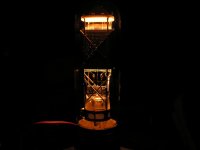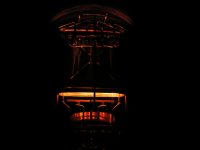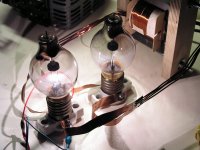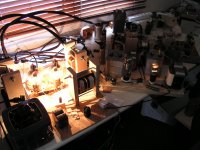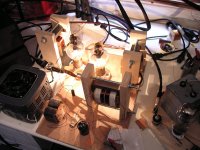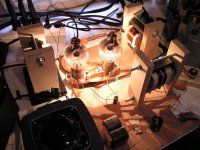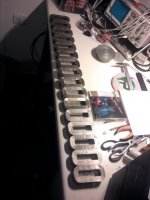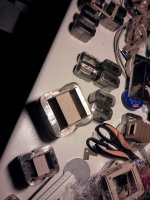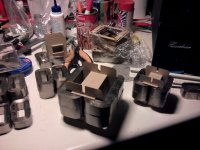Tempered glass is not bad, even if it takes something out of the magic. For this machine there is provision for such a piece but we'll see in the future.
There exist ventilation ports in all the cases where heat generation is above critical limits. All power transformers run very cool, as no piece is stressed above 11.000 Gauss and wire resistance is not high.
Some more pics will be uploaded during the next days.
There exist ventilation ports in all the cases where heat generation is above critical limits. All power transformers run very cool, as no piece is stressed above 11.000 Gauss and wire resistance is not high.
Some more pics will be uploaded during the next days.
Chassis is not painted, natural corian color without further painting. Absolutely seamless
Xfmr and choke covers in Corian as well?!
Jaz
The tube caps are still missing, waiting for them!
Why use a cage around it? Afraid of being killed of electricity? Not a chance!
If you want to commit suicide, there still exist other alternative ways
And much better! And faster of course!
Why suicide? Accident. Hooked a cable by foot, fell down on the amp, too late to call ambulance...
Why suicide? Accident. Hooked a cable by foot, fell down on the amp, too late to call ambulance...
also never use sharp knives, even if you are very hungry.
if you fall on them you might die
also never use sharp knives, even if you are very hungry.
if you fall on them you might die
http://www.diyaudio.com/forums/tubes-valves/30172-safety-practices-general-ultra-high-voltage.html
211 exotic amp specifications
After a couple of days I have found some time to sit down and write a few words about the specs of this amplifier. So let's start...
As previously written, it is a Class A2 power amplifier based on 211 transmitter tube, with 300B driver tube and Emission Labs 20A input tube. So we have three active stages, all anode driven, no transistors (as previously questioned) anywhere of course. It is a zero feedback design (locally or globally) with nominal power output at 35 Watts per channel.
All tubes have been selected to be Directly Heated Triodes, this was the 1st prerequisite for this amp, no indirectly heated valves were allowed. The 2nd prerequisite was the inductive loading of all stages, no capacitor was allowed to be used. The third was to use exclusively tape wound cores, no E-I iron was allowed for this project, so I ended up using double c core transformers and chokes everywhere. The signal transformers are wound around 0.1mm CRGO c cores and all others around 0.23mm CRGO c cores. Then come other prerequisite parameters like one secondary coil per transformer, only oil capacitors in High Voltage filtration circuits, only Mercury Vapor tubes for rectification, and then only the best parts and components, vintage or modern, without the slightest compromise. And finally come the aesthetics, I wanted to show something extraordinary, different than anything presented so far. The amp should reflect the philisophy of both the designer and the owner, about aesthetics. It should follow classic design lines with lots of transformer covers but presented in a contemporary 'feel' without bolts and eye-catching candies, the amp should look not like a monster but like a generous giant relaxing close to each speaker.
The output transformer has been designed to provide best sound and best measurements and it is the only part in this amp with balanced compromises. After all, it couldn't be otherwise. If you are forced to squeeze so much clean and undistorted power out of a 211 tube, you have to balance out some compromises that mother nature imposes. I could get slightly more power out of this monster (aca smaller tube load), I could get slighly better high freq response (aca fewer primary turns), I could get slightly better sound, but the balance of all those three are now reflected through the end result. The combination of the previously mentioned parameters is what you will listen when you sit in front of the loudspeakers.
Regarding the schematics of this amp, there is no need to mention anything. Actually, for this amp there exists no schematic at all, it cannot be elaborated differently. From input RCA socket you go to EML20A's grid shunted at 47kOhms, from input tube's anode you go straight to 300B's grid through the 1st interstage transformer, from 300B's anode you go straight to 211's grid through the second interstage transformer and then to the loudspeaker. All tubes are self-biased and DC heated through separate power supplies of course and current source devices.
The unique feature of this amp is absolute load linearity down to 20 Hz, that means the tubes operate at a stable and completely linear load from subsonics to ultrasonics. The interstage transformers have an enormous amount of turns and are immensely sized in order to achieve maximum frequency response with minimal DC resistance of the coils. Specially for the driver tube, only 300B is able to drive 211 tube to its maximum potential as the output tube goes heavily in Class A2 mode of operation. Minimal DC resistance and enormously high inductance are both a prerequisite for this purpose.
Apart of the above mentioned things there exists of course many others that are totally unseen and of course remain undisclosed. All these relate to the coil winding technique and I think they are far away from the purpose of this presentation.
The whole project from design to final installation lasted a year but we have to include several delay issues, summer holidays, etc.
Unfortunately there is no way to take any picture from the downside, as the weight of each amp is enormous. Actually, there is almost nothing lying there, only filament rectification diodes, filament filtration capacitors and the filament heaters close to the tubes.
After many hours of operation the amp runs cool, unexpectedly cool. All the transformers inside operate slightly warm to the touch and totally silent. The cathode resistors have been mounted on heat sinks although this was not necessary. The transformers that generate minimal heat have been covered with vented covers not seen from above, as the vent holes are located on the sides of the corian boxes. Themal stress of all components is sub-minimal to the point of unnecessary.
When plugging the amp on the speakers, at first we thought that something was wrong because there was no noise coming out of the supertweeter. The amp was dead silent with my ear sticked on the supertweeter. I measured the noise on the output and the meter showed 0.000 V. Something was certainly wrong with the connection. When the play button of the CD was pressed the sudden eruption of sound was so violent that threatened us like never before. Unfortunately I have no way to measure the noise level. The amp provides clean and undistorted power up to 35W RMS down to 23 Hz and the bass performance is extraordinary on Jadis Eurythmie loudspeakers. To be honest I have never experienced such a bass performance but anyway, this does not come unexpectedly because it is a result of the specs. The speaker is claimed to be able to go down to 18Hz, anyway I do not think that this is the most important in proper music reproduction. The amp reaches 30kHz from input to output and this is a reflection of the OPT operation only (and the Miller effect of 211 tube which is not unimportant at all). I could easily reach 45kHz but then other compromises arise, so both the owner and I decided to stay there.
The level of the performance of this amplifier qualifies as extraordinary in all aspects, compared to any SET amp around. I know this first hand because I am both the designer of the amp and the coil winder of all iron pieces inside. IMHO it is the best demonstration of the pure undistorded SET sound when only music performance matters. There is no need to stay anymore on performance description because all visitors here are already exposed to good SET sound. Unfortunately, like in all good SET amps, the amplifier's cost is absolutely insane and out of this world. It might sound absolutely crazy to the inexperienced, but things cannot be done differently. Good SET sound, away from usual compromises and well known issues, is extremely expensive.
Practically there is no sky to reach because there always exists something better. This always happens in life. We all know this very well. However, if you think that this is might well be the end of the road, I need to underline that this level of performance and design complexity, has to be accepted as 'expected', taking in mind my knowledge as a mechanical engineer with more than 15 years of experience, my winding skills, and the boundaries of my imagination. I have already been asked to manufacture the next exotic power amplifier with performance and design complexity to a totally other degree, and much costlier of course. This next project will be equipped with tubes rectification in both HV and fillament supplies, exotic iron c cores throughout with magnitudes of order higher cost, two-chassis per monoblock design, etc. And all this for 10 Watts of pure undistorted SET power. Stay tuned...
Happy holidays to everybody!
After a couple of days I have found some time to sit down and write a few words about the specs of this amplifier. So let's start...
As previously written, it is a Class A2 power amplifier based on 211 transmitter tube, with 300B driver tube and Emission Labs 20A input tube. So we have three active stages, all anode driven, no transistors (as previously questioned) anywhere of course. It is a zero feedback design (locally or globally) with nominal power output at 35 Watts per channel.
All tubes have been selected to be Directly Heated Triodes, this was the 1st prerequisite for this amp, no indirectly heated valves were allowed. The 2nd prerequisite was the inductive loading of all stages, no capacitor was allowed to be used. The third was to use exclusively tape wound cores, no E-I iron was allowed for this project, so I ended up using double c core transformers and chokes everywhere. The signal transformers are wound around 0.1mm CRGO c cores and all others around 0.23mm CRGO c cores. Then come other prerequisite parameters like one secondary coil per transformer, only oil capacitors in High Voltage filtration circuits, only Mercury Vapor tubes for rectification, and then only the best parts and components, vintage or modern, without the slightest compromise. And finally come the aesthetics, I wanted to show something extraordinary, different than anything presented so far. The amp should reflect the philisophy of both the designer and the owner, about aesthetics. It should follow classic design lines with lots of transformer covers but presented in a contemporary 'feel' without bolts and eye-catching candies, the amp should look not like a monster but like a generous giant relaxing close to each speaker.
The output transformer has been designed to provide best sound and best measurements and it is the only part in this amp with balanced compromises. After all, it couldn't be otherwise. If you are forced to squeeze so much clean and undistorted power out of a 211 tube, you have to balance out some compromises that mother nature imposes. I could get slightly more power out of this monster (aca smaller tube load), I could get slighly better high freq response (aca fewer primary turns), I could get slightly better sound, but the balance of all those three are now reflected through the end result. The combination of the previously mentioned parameters is what you will listen when you sit in front of the loudspeakers.
Regarding the schematics of this amp, there is no need to mention anything. Actually, for this amp there exists no schematic at all, it cannot be elaborated differently. From input RCA socket you go to EML20A's grid shunted at 47kOhms, from input tube's anode you go straight to 300B's grid through the 1st interstage transformer, from 300B's anode you go straight to 211's grid through the second interstage transformer and then to the loudspeaker. All tubes are self-biased and DC heated through separate power supplies of course and current source devices.
The unique feature of this amp is absolute load linearity down to 20 Hz, that means the tubes operate at a stable and completely linear load from subsonics to ultrasonics. The interstage transformers have an enormous amount of turns and are immensely sized in order to achieve maximum frequency response with minimal DC resistance of the coils. Specially for the driver tube, only 300B is able to drive 211 tube to its maximum potential as the output tube goes heavily in Class A2 mode of operation. Minimal DC resistance and enormously high inductance are both a prerequisite for this purpose.
Apart of the above mentioned things there exists of course many others that are totally unseen and of course remain undisclosed. All these relate to the coil winding technique and I think they are far away from the purpose of this presentation.
The whole project from design to final installation lasted a year but we have to include several delay issues, summer holidays, etc.
Unfortunately there is no way to take any picture from the downside, as the weight of each amp is enormous. Actually, there is almost nothing lying there, only filament rectification diodes, filament filtration capacitors and the filament heaters close to the tubes.
After many hours of operation the amp runs cool, unexpectedly cool. All the transformers inside operate slightly warm to the touch and totally silent. The cathode resistors have been mounted on heat sinks although this was not necessary. The transformers that generate minimal heat have been covered with vented covers not seen from above, as the vent holes are located on the sides of the corian boxes. Themal stress of all components is sub-minimal to the point of unnecessary.
When plugging the amp on the speakers, at first we thought that something was wrong because there was no noise coming out of the supertweeter. The amp was dead silent with my ear sticked on the supertweeter. I measured the noise on the output and the meter showed 0.000 V. Something was certainly wrong with the connection. When the play button of the CD was pressed the sudden eruption of sound was so violent that threatened us like never before. Unfortunately I have no way to measure the noise level. The amp provides clean and undistorted power up to 35W RMS down to 23 Hz and the bass performance is extraordinary on Jadis Eurythmie loudspeakers. To be honest I have never experienced such a bass performance but anyway, this does not come unexpectedly because it is a result of the specs. The speaker is claimed to be able to go down to 18Hz, anyway I do not think that this is the most important in proper music reproduction. The amp reaches 30kHz from input to output and this is a reflection of the OPT operation only (and the Miller effect of 211 tube which is not unimportant at all). I could easily reach 45kHz but then other compromises arise, so both the owner and I decided to stay there.
The level of the performance of this amplifier qualifies as extraordinary in all aspects, compared to any SET amp around. I know this first hand because I am both the designer of the amp and the coil winder of all iron pieces inside. IMHO it is the best demonstration of the pure undistorded SET sound when only music performance matters. There is no need to stay anymore on performance description because all visitors here are already exposed to good SET sound. Unfortunately, like in all good SET amps, the amplifier's cost is absolutely insane and out of this world. It might sound absolutely crazy to the inexperienced, but things cannot be done differently. Good SET sound, away from usual compromises and well known issues, is extremely expensive.
Practically there is no sky to reach because there always exists something better. This always happens in life. We all know this very well. However, if you think that this is might well be the end of the road, I need to underline that this level of performance and design complexity, has to be accepted as 'expected', taking in mind my knowledge as a mechanical engineer with more than 15 years of experience, my winding skills, and the boundaries of my imagination. I have already been asked to manufacture the next exotic power amplifier with performance and design complexity to a totally other degree, and much costlier of course. This next project will be equipped with tubes rectification in both HV and fillament supplies, exotic iron c cores throughout with magnitudes of order higher cost, two-chassis per monoblock design, etc. And all this for 10 Watts of pure undistorted SET power. Stay tuned...
Happy holidays to everybody!
Last edited:
Here is some inspiration from "Glass Audio 1/1994, blz 12, by Nobu K. Shishido":
"A vice managing director of Nippon Phonogram built a stereo amp "system" that employs 30 Western Electric DHT's from the pre-amp stage down to the power output stage. Each stage is equipped with two IT's - in and out. So the signal must go through seven IT's/channel before it reaches an OPT. The power stage is a pair of WE284D's (WE version of 845) in push pull, driven by a pair of 300B's, again in push-pull, through a huge IT to an IT connection. The sounds thus produced through Quad's ESL63 amaze visiting Philips artists and audio engineers.
"A vice managing director of Nippon Phonogram built a stereo amp "system" that employs 30 Western Electric DHT's from the pre-amp stage down to the power output stage. Each stage is equipped with two IT's - in and out. So the signal must go through seven IT's/channel before it reaches an OPT. The power stage is a pair of WE284D's (WE version of 845) in push pull, driven by a pair of 300B's, again in push-pull, through a huge IT to an IT connection. The sounds thus produced through Quad's ESL63 amaze visiting Philips artists and audio engineers.
And in order to have a better idea of what is coming, here are some more pics.
There are dozens of exotic, custom designed and custom ordered c core pieces waiting to be wound.
Here you get a brief idea of the double and quadruble filament transformer c cores. And you see the argon filament rectifiers in full operation!
As I have written you before, when you have the knowledge, the skills and the imagination, there is practically no boundary that can be seen as an obstacle, in all aspects of life. Remember that I have been grown and live in Greece. Although we're still sufferring from deep economic recession, we have proven historically for thousands of years, that free spirit, imagination and inspiration to offer the best to humanity, never die in this country! This is the way we have been grown and we live our lives.
Have a nice day!
There are dozens of exotic, custom designed and custom ordered c core pieces waiting to be wound.
Here you get a brief idea of the double and quadruble filament transformer c cores. And you see the argon filament rectifiers in full operation!
As I have written you before, when you have the knowledge, the skills and the imagination, there is practically no boundary that can be seen as an obstacle, in all aspects of life. Remember that I have been grown and live in Greece. Although we're still sufferring from deep economic recession, we have proven historically for thousands of years, that free spirit, imagination and inspiration to offer the best to humanity, never die in this country! This is the way we have been grown and we live our lives.
Have a nice day!
Attachments
And in order to have a better idea of what is coming, here are some more pics.
There are dozens of exotic, custom designed and custom ordered c core pieces waiting to be wound.
Here you get a brief idea of the double and quadruble filament transformer c cores. And you see the argon filament rectifiers in full operation!
As I have written you before, when you have the knowledge, the skills and the imagination, there is practically no boundary that can be seen as an obstacle, in all aspects of life. Remember that I have been grown and live in Greece. Although we're still sufferring from deep economic recession, we have proven historically for thousands of years, that free spirit, imagination and inspiration to offer the best to humanity, never die in this country! This is the way we have been grown and we live our lives.
Have a nice day!
Nice. By the way, I heard your government is contemplating about a tube amp tax
- Status
- This old topic is closed. If you want to reopen this topic, contact a moderator using the "Report Post" button.
- Home
- Amplifiers
- Tubes / Valves
- Most exotic SET power amplifier
